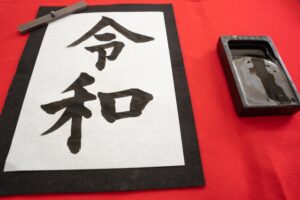Have you ever seen a cool T-shirt or a tattoo with a Japanese Kanji character and wondered what it really means?
Choosing a kanji just for its looks can sometimes lead to embarrassing mistakes!
This guide will introduce you to the top 10 most popular kanji among foreigners and explain their true, deeper meanings, so you can choose your favorite with confidence.
You can find many T-shirts with these kanji at stores like Don Quijote, but a huge variety of designs are also available online.
Top 10 Popular Kanji and Their Meanings
1. 侍 (Samurai)
Meaning: The Noble Warrior of Japan.
This character represents more than just a “warrior.”
It embodies the spirit of Bushido—a code of honor, loyalty, discipline, and courage.
It’s a powerful symbol of old Japan.
2. 忍 (Ninja / Shinobi)
Meaning: To Endure, To Conceal.
This character is the symbol of the ninja, Japan’s legendary covert agents.
It carries an image of stealth, speed, and silent perseverance, making it incredibly popular worldwide.
3. 龍 (Ryū / Dragon)
Meaning: Dragon.
Unlike Western dragons, Eastern dragons are sacred, powerful beings that symbolize strength, good fortune, and control over water.
It’s an iconic symbol of East Asian culture.
4. 愛 (Ai / Love)
Meaning: Love.
A universal theme. In Japanese, “Ai” can carry a nuance of deep, unconditional, and sometimes even fated love, making it a very profound and popular character.
5. 幸 (Kō / Sachi / Happiness)
Meaning: Happiness, Good Fortune, Bliss.
This character represents a state of being happy and blessed. It’s a positive and universally understood desire for a happy life, often wished upon others.
6. 武 (Bu / Warrior)
Meaning: Warrior, Martial, Military.
This character relates to the martial arts (“Budō”) and represents bravery, physical strength, and the “way of the warrior.”
Its powerful image is very appealing.
7. 美 (Bi / Beauty)
Meaning: Beauty.
This character represents physical beauty as well as the Japanese aesthetic sense of beauty in art and nature.
It has an elegant shape and a universally positive meaning.
8. 桜 (Sakura / Cherry Blossom)
Meaning: Cherry Blossom.
The iconic symbol of spring in Japan.
It represents not only beauty but also the transient, ephemeral nature of life, a key concept in Japanese aesthetics.
9. 福 (Fuku / Good Fortune)
Meaning: Good Fortune, Luck, Blessing.
This character is often seen on good luck charms (“omamori”) and symbolizes blessings and good fortune coming your way.
A lucky symbol everyone can appreciate.
10. 心 (Kokoro / Heart, Mind, Spirit)
Meaning: Heart, Mind, Spirit.
This is a very deep character that encompasses the English concepts of “heart” (emotions), “mind” (thoughts), and “spirit” (consciousness) all in one.
Tips for Choosing Your Kanji
- Don’t choose a kanji based on looks alone! Always check its multiple meanings and nuances.
- Remember that the font or calligraphy style can dramatically change the feeling of the character.
Kanji are a beautiful art form, with each character telling a deep story.
Use this guide to find a special character that resonates with you and enjoy this part of Japanese culture!
You Might Also Like
If you’re thinking of getting a permanent kanji tattoo, it’s important to understand the local culture around tattoos.
Our guide explains everything you need to know.
Traveling to Japan with Tattoos? 【Your Complete Guide】 to Onsen & Pools








